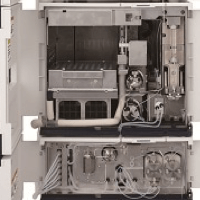Liquid Chromatography
Liquid Chromatography deals with those analytes that can’t be vaporized due to low volatility, denaturing or destruction of the sample of interest. As such this analysis technique is used extensively by biochemists, clinicians and for drug testing.
Most Liquid chromatography is actually High Pressure Liquid Chromatography (HPLC). In this form of analysis an analyte is introduced into a mobile phase before being transported through a column, which achieves separation of the mixture. The mobile phase is normally water mixed with varying amounts of acetonitrile or methanol with a small amount of acid (acetic or formic) to improve peak shape/ act as a source of protons for reversed phase HPLC.
The HPLC column is generally a packed column (particle size approx. 5μm) between 5 and 25cm in length and between 4 and 10 mm in diameter. The particle size and make up of the packing is a crucial factor in separating analytes in HPLC. HPLC runs at pressures between 50 and 350 bar.
After leaving the column, the separated sample passes through a detector, normally a UV-Vis / Diode Array detector, to quantify the amount of each compound present. HPLC systems are often attached to mass spectrometers for absolute identification of the component analytes.
HPLC systems can use a large variety of columns and detectors, allowing a wide range of compounds to be analysed using this method. Click on the links below to explore our equipment.
